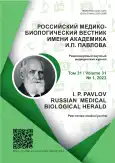Two Rare Anatomical Variants of Femoral Triangle Vessels in One Patient: Case Report
- 作者: Kalinin R.E.1, Suchkov I.A.1, Klimentova E.A.1, Shanayev I.N.1, Khashumov R.M.1, Korbut V.S.1
-
隶属关系:
- Ryazan State Medical University
- 期: 卷 31, 编号 1 (2023)
- 页面: 127-136
- 栏目: Clinical reports
- URL: https://bakhtiniada.ru/pavlovj/article/view/252530
- DOI: https://doi.org/10.17816/PAVLOVJ109525
- ID: 252530
如何引用文章
详细
INTRODUCTION: The upper third of thigh — the area of the femoral triangle, or Scarpa’s triangle, is of great importance both in anatomy and vascular surgery. It is the place of passage of the main vessels of the lower extremities: the femoral artery, femoral vein and their largest tributaries which are easily accessible in this region due to their superficial location. To note, in the vascular surgery, the femoral vessels are divided to common and superficial ones depending on the level of their location relative to deep femoral vessels. This division is extremely important in the functional aspect, since deep femoral vessels may significantly compensate for the blood flow in case of impaired patency of the superficial femoral vessels. Besides, an important tributary of the common femoral vein is the great saphenous vein forming saphenofemoral junction. Classic anatomy describes vessels of the upper third of thigh as single trunks with permanent topography. At the same time, in the literature there are commonly encountered reports of duplication of the superficial femoral vein, two trunks of the deep femoral artery, and relatively rare reports of atypical saphenofemoral junctions (about 0.02%). The work describes anatomical variants of the FT vessels in one patient: atypical saphenofemoral junction on the right and duplication of the common femoral vein on the left, two trunks of the deep femoral artery on both sides.
CONCLUSION: The anatomical variants of FT vessels described in the article, are rare. It is important that clinicians know about them to avoid errors in diagnosis or surgical treatment.
作者简介
Roman Kalinin
Ryazan State Medical University
Email: kalinin-re@yandex.ru
ORCID iD: 0000-0002-0817-9573
SPIN 代码: 5009-2318
MD, Dr. Sci. (Med.); Professor
俄罗斯联邦, RyazanIgor' Suchkov
Ryazan State Medical University
Email: suchkov_med@mail.ru
ORCID iD: 0000-0002-1292-5452
SPIN 代码: 6473-8662
MD, Dr. Sci. (Med.); Professor
俄罗斯联邦, RyazanEmma Klimentova
Ryazan State Medical University
Email: klimentowa.emma@yandex.ru
ORCID iD: 0000-0003-4855-9068
SPIN 代码: 5629-9835
MD, Cand. Sci. (Med.)
俄罗斯联邦, RyazanIvan Shanayev
Ryazan State Medical University
编辑信件的主要联系方式.
Email: c350@yandex.ru
ORCID iD: 0000-0002-8967-3978
SPIN 代码: 5524-6524
MD, Dr. Sci. (Med.)
俄罗斯联邦, RyazanRuslan Khashumov
Ryazan State Medical University
Email: kardiokt@yandex.ru
ORCID iD: 0000-0002-9900-0363
SPIN 代码: 8495-9819
俄罗斯联邦, Ryazan
Viktor Korbut
Ryazan State Medical University
Email: viktorkorbut21@gmail.com
ORCID iD: 0000-0001-5478-1111
SPIN 代码: 9440-3048
俄罗斯联邦, Ryazan
参考
- Ascher E, editor. Haimovici's Vascular Surgery. 6th ed. Blackwell Publishing Ltd; 2012.
- Diagnostics and Treatment of Chronic Venous Disease: Guidelines of Russian Phlebological Association. Flebologiya. 2018;(3):146–240. (In Russ).
- Sidawy AN, Perler BA. Rutherford’s Vascular Surgery and Endovascular Therapy. 9th ed. Elsevier; 2018.
- Matyushkin AA, Lobachev AA. Methods for improving the results of using a synthetic prosthesis in the popliteal-tibial segment in critical limb ischemia. I. P. Pavlov Russian Medical Biological Herald. 2020;28(2):200–12. (In Russ). doi: 10.23888/PAVLOVJ2020282200-212
- Caggiati A, Bergan JJ, Gloviczki P, et al. Nomenclature of the veins of the lower limbs: an international interdisciplinary consensus statement. Journal of Vascular Surgery. 2002;36(2):416–22. doi: 10.1067/mva.2002.125847
- Gayvoronskiy IV. Normal’naya anatomiya cheloveka. Saint-Petersburg: SpecLit; 2020. Vol. 2. (In Russ).
- Kalinin RE, Suchkov IA, Klimentova EA, et al. Clinical anatomy of deep femoral vessels in the area of femoral triangle. Angiology and Vascular Surgery. 2021;27(1):17–22. (In Russ). doi: 10.33529/ANGIO2021107
- Kalinin RE, Suchkov IA, Shanaev IN. Rare Topography of the Common Femoral Vein. Flebologiya. 2020;14(4):356–61. (In Russ). doi: 10.17116/flebo202014041356
- Kalinin RE, Suchkov IA, Puchkova GA, et al. Variants of topography of vessels of the trigonum femorale Scarpae zone. Avicenna Bulletin. 2017;19(3):431–5. (In Russ). doi: 10.25005/2074-0581-2017-19-3-431-435
- Vakhitov MSh, Radionov KK, Chekhuta SM, et al. Rol’ anatomicheskogo faktora v razvitii pervichnogo varikoznogo rasshireniya ven nizhnikh konechnostey. Regional’noye Krovoobrashcheniye i Mikrotsirkulyatsiya. 2005;(2):20–4. (In Russ).
- Kalinin RE, Suchkov IA, Klimentova EA, et al. Rare version of topography of deep femoral artery. Nauka Molodykh (Eruditio Juvenium). 2020;8(4):591–8. (In Russ). doi: 10.23888/HMJ202084591-598
- Shval’b PG, Ukhov YuI. Patologiya venoznogo vozvrata iz nizhnikh konechnostey. Ryazan’: Tigel’; 2009. (In Russ).
- Bol'shakov OP, Semenov GM. Operativnaya khirurgiya i topograficheskaya anatomiya. Saint-Petersburg: Piter; 2004. (In Russ).
- Uhl J–F, Gillot C, Chahim M. Anatomical variations of the femoral vein. Journal of Vascular Surgery. 2010;52(3):714–9. doi: 10.1016/j.jvs.2010.04.014
- Mazayshvili KV, Khlevtova TV, Akimov SS, et al. Ul’trazvukovaya anatomiya ven nizhnikh konechnostey. Moscow: Medpraktika; 2016. (In Russ).
- Kovanov VV, Anikina TV. Khirurgicheskaya anatomiya arteriy cheloveka. Moscow: Meditsina; 1974. (In Russ).
- Kim DS, Kim SW, Lee HS, et al. Rare Vascular Anomalies in the Femoral Triangle During Varicose Vein Surgery. The Korean Journal of Thoracic and Cardiovascular Surgery. 2017;50(2):99–104. doi: 10.5090/kjtcs.2017.50.2.99
- Litvinenko LM. Sosudisto-nervnyye kompleksy tela cheloveka. Moscow: Biznes Olimp; 2011. (In Russ).
- Stojko YuM, Mazaĭshvili KV. On embryogenesis of the lower limb venous system in man. Flebologiya. 2010;4(1):4–10. (In Russ).
补充文件











